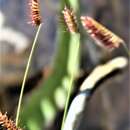Comprehensive Description
provided by North American Flora
Bouteloua breviseta Vasey, Contr. U. S. Nat. Herb. 1: 58. 1890
Bouteloua raniosa Scribn.; Vasey, Bull. U. S. Dep. Agr. Bot. 12': pi. 44. 1890. (Type from Santa
Kulalia mountains. Chihuahua, Mexico, Wilkinson.) Bouleloua oligoslachya var. ramo^a Scribn.; Beal, Grasses N. Am. 2: 418. 1896. (Based on B.ramosa
Scribn.)
Perennial; culms in small hard clumi)S from a knotty base, stiff, wiry, branching, erect or spreading, often geniculate at the nodes, 20-50 cm. tall, glabrous, the nodes pubescent; sheaths glabrous, the margins ciliate, more or less pilose in the throat; ligule ciliate, about 0.5 mm. long; blades firm, stiff, pungently pointed, loosely involute, curved, spreading, 1.5-7 cm. long, 1-1.5 mm. wide, glabrous; spikes 1-3, 1-3.5 cm. long, somewhat curved, ascending or spreading; first glume very narrow, acuminate, 2 mm. long; second glume broader, acute, 3 ram. long, glabrous; lemma 4 mm. long, shortly bearded at the base, pilose over the entire back, the tip minutely bifid, the central awn about 1 mm. long, the lateral ones a little longer; rudiment long-bearded at the base, rather deeply cleft, the awns 3-4 mm. long, a second awnless cucuUate rudiment developed.
Type locality: Presidio County, Texas (Nealley 660).
Dlstribution : Dry prairies and rockv hills, western Texas, New Mexico, and northern Mexico.
- bibliographic citation
- Albert Spear Hitchcock, Jason Richard Swallen, Agnes Chase. 1939. (POALES); POACEAE (pars). North American flora. vol 17(8). New York Botanical Garden, New York, NY
Physical Description
provided by USDA PLANTS text
Perennials, Terrestrial, not aquatic, Rhizomes present, Rhizome short and compact, stems close, Rhizome elongate, creeping, stems distant, Stems nodes swollen or brittle, Stems erect or ascending, Stems caespitose, tufted, or clustered, Stems terete, round in cross section, or polygonal, Ste ms branching above base or distally at nodes, Stem internodes hollow, Stems with inflorescence less than 1 m tall, Stems, culms, or scapes exceeding basal leaves, Leaves mostly basal, below middle of stem, Leaves conspicuously 2-ranked, distichous, Leaves sheathing at base, Leaf sheath mostly open, or loose, Leaf sheath smooth, glabrous, Leaf sheath hairy at summit, throat, or collar, Leaf sheath and blade differentiated, Leaf blades linear, Leaf blades very narrow or filiform, less than 2 mm wide, Leaf blades mostly flat, Leaf blade margins folded, involute, or conduplicate, Leaf blades mostly glabrous, Leaf blades more or less hairy, Ligule present, Ligule a fringe of hairs, Inflorescence terminal, Inflorescence with 2 or more spikes, fascicles, glomerules, heads, or clusters per culm, Inflorescence a panicle with narrowly racemose or spicate branches, Inflorescence with 2-10 branches, Inflorescence branches 1-sided, Inflorescence branches terminating in bristle or point, Flowers bisexual, Spikelets sessile or subsessile, Spikelets laterally compressed, Spikelet less than 3 mm wide, Spikelets with 1 fertile floret, Spikelets solitary at rachis nodes, Spikelets all alike and fertille, Spikelets bisexual, Spikelets disarticulating above the glumes, glumes persistent, Spikelets secund, in rows on one side of rachis, Rachilla or pedicel glabrous, Glumes present, empty bracts, Glumes 2 clearly present, Glumes equal or subequal, Glumes equal to or longer than adjacent lemma, Glume equal to or longer than spikelet, Glumes 1 nerved, Lemma coriaceous, firmer or thicker in texture than the glumes, Lemma 3 nerved, Lemma glabrous, Lemma body or surface hairy, Lemma apex dentate, 3-5 fid, Lemma teeth unequal. central tooth longer, Lemma distinctly awned, more than 2-3 mm, Lemma with 3 awns, Lemma awn less than 1 cm long, Lemma margins thin, lying flat, Lemma straight, Palea present, well developed, Palea membranous, hyaline, Palea shorter than lemma, Pale a 2 nerved or 2 keeled, Stamens 3, Styles 2-fid, deeply 2-branched, Stigmas 2, Fruit - caryopsis, Caryopsis ellipsoid, longitudinally grooved, hilum long-linear.

